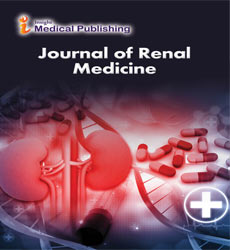Role of the Von Hippel-Lindau Pathway in Clear Cell Renal Cell Carcinoma from Molecular Mechanisms to Targeted Therapies
Jihad Ibrahimi*
Department of Urology, University of Rabat, Rabat, Morocco
- *Corresponding Author:
- Jihad Ibrahimi
Department of Urology, University of Rabat, Rabat,
Morocco,
E-mail: ibrahimi@hotmail.com
Received date: June 17, 2024, Manuscript No. IPJRM-24-19502; Editor assigned date: June 19, 2024, PreQC No. IPJRM-24-19502 (PQ); Reviewed date: July 03, 2024, QC No. IPJRM-24-19502; Revised date: July 10, 2024, Manuscript No. IPJRM-24-19502 (R); Published date: July 17, 2024, DOI: 10.36648/ipjrm.7.4.35
Citation: Ibrahimi J (2024) Role of the Von Hippel-Lindau Pathway in Clear Cell Renal Cell Carcinoma from Molecular Mechanism to Trageted Therapies. J R en Med Vol.7 No.4: 3 5.
Description
Renal Cell Carcinoma (RCC) is the most widely recognized kind of kidney disease in grown-ups and one of the deadliest urological tumors, representing 90% of dangerous neoplasms of the kidney and 2%-3% of all malignant growths. RCC is difficult to manage because it surround a diverse group of cancers with distinct histological subtypes, distinct genetic and molecular alterations, and distinct clinical outcomes. The main histological subtypes of clear cell RCC (ccRCC), papillary RCC (pRCC), and chromophobe RCC (chRCC) are identified by the World Health Organization (WHO). The most prevalent subtype, ccRCC, accounts for 80% of adult cases of malignant RCC. Additionally, unknown primary cancers with an RCC profile are treated as RCC, which may also be a factor in the observed rise in RCC cases. A type of renal cortical tumor known as ccRCC arises from the proximal renal tubule and is distinguished by the presence of malignant epithelial cells with clear cytoplasm as a result of the abnormal accumulation of lipids.
Early detection strategies
This disease subtype has a sweeping development design, entwined with a complex vasculature which brings about an exceptionally forceful nature. Different histopathological factors influence the guess of ccRCC patients, with growth grade being especially vital. The International Society of Urological Pathologists (ISUP) proposed another reviewing framework essentially focused on assessing cancer nucleoli, showing a more grounded relationship with patient movement contrasted with the fuhrman framework. As a result, the ISUP grade is now incorporated into patient risk assessment systems to predict the likelihood of metastatic disease progression in individuals with localized ccRCC and now holds significant prognostic value. The rising utilization of routine stomach imaging assessments did because of vague side effects irrelevant to the sickness has brought about the accidental recognition of restricted ccRCC at a beginning phase. Localized ccRCC can only be treated surgically at this time. This is because ccRCC tumors are resistant to conventional treatments like chemo and radiotherapy due to their extreme aggressiveness and hypoxic environment. The Von Hippel-Lindau (VHL) pathway, which is one of the best-characterized pathways involved in ccRCC, is closely linked to this characteristic aggressiveness. The Hypoxia-Inducible Factor (HIF)-1 and HIF-2 protein levels are stabilized by this loss of VHL, preventing their degradation and causing the tumor cell to enter a state of pseudohypoxia. In this state, HIF-1α and HIF-2α increment the declaration of qualities engaged with cell multiplication and cancer angiogenesis, as well as those encoding Transforming Growth Factor-α (TGF-α), Vascular Endothelial Growth Factor (VEGF) and Platelet-Determined Development Factor (PDGF), which advance tumorigenesis.
Treatment strategies
The collaboration between these qualities and their receptors Epidermal Growth Factor Receptor (EGFR). Vascular Endothelial Development Element Receptor (VEGFR) and Platelet Derived Growth Factor Receptor (PDGFR) in ccRCC cells can enact different flagging pathways, including the Phosphatidylinositol 3-Kinase (PI3K) pathway, a critical pathway in the guideline of ccRCC tumorigenesis. Activation of PI3K results in the production of phosphatidylinositol-3,4,5-triphosphate, which in turn causes AKT to be activated. The dynamic type of AKT then, at that point, initiates the mammalian Target Of Rapamycin Complex 1 (mTORC1), directing the declaration of qualities answerable for cell endurance and advancing cell expansion, digestion, relocation, intrusion, angiogenesis and hindrance of apoptosis. When mTORC1 is positively regulated, it can also increase the expression of the HIF-1 subunit, forming a positive feedback loop that accelerates tumor growth. Anti-angiogenic strategies, on the other hand, have emerged as an appealing strategy because of the low response rate to this immunotherapy and the growing understanding of the highly hypoxic environment of ccRCC. At present, the most broadly utilized designated treatments center around Tyrosine Kinase Inhibitors (TKIs), particularly those that focus on the VEGF pathway. These targeted therapies have a number of associated adverse events, despite their potential to improve disease control rates and extend survival. To better optimize and develop new treatments for patients with advanced ccRCC, it is therefore necessary to gain a deeper comprehension of the molecular mechanisms underlying the disease. Phosphatase and Tensin Homolog (PTEN) emerged as a potential treatment target and a vital factor in tumor progression and disease prognosis. Besides, different investigations likewise propose that PTEN might act through AKT-free components. Due to their anti-proliferative properties, PTEN inactivation is frequently observed in various types of cancer.
Open Access Journals
- Aquaculture & Veterinary Science
- Chemistry & Chemical Sciences
- Clinical Sciences
- Engineering
- General Science
- Genetics & Molecular Biology
- Health Care & Nursing
- Immunology & Microbiology
- Materials Science
- Mathematics & Physics
- Medical Sciences
- Neurology & Psychiatry
- Oncology & Cancer Science
- Pharmaceutical Sciences
